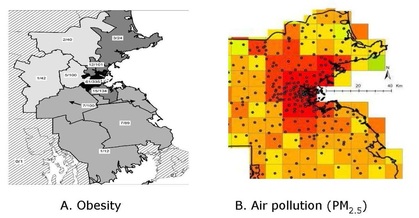 by Emily Oken, MD, MPH We’ve all heard there’s an epidemic of obesity around the world– obesity is increasing in adults and children, and even infants, in all continents. With such a wide swath of the world’s population being affected, you might be tempted to think there’s something in the air that is causing everyone to gain weight – and you may be right. Our group is collaborating with scientists in the Clean Air Research Center at the Harvard School of Public Health to understand how air pollution affects a number of health outcomes, including obesity. When we looked at the rates of obesity among children living in eastern Massachusetts who were enrolled in our Project Viva study we found that the neighborhoods with the most obese children (panel A, darker areas) were also the same with the most air pollution (panel B – redder areas). So how can it be that exposure to air pollution might cause obesity? Emissions from cars and power plants include particles that so are small that once they are inhaled, they reach deep into the lungs and are absorbed directly into the bloodstream. These tiny particles (called PM2.5, for their size of 2.5 micrometers or less in diameter) can then cause inflammation which may promote accumulation of fat cells, affect brain regions that influence appetite and activity, and damage blood vessels. In fact, we recently found that pregnant women living in areas with higher traffic-related pollution had babies who were smaller at birth, but then grew much faster and had higher weight for length by 6 months of age. Of course, more urban neighborhoods with greater air pollution also have other characteristics that might promote obesity, such as poor access to healthy foods and safe places to exercise. We try to account for these factors in our analyses, but don’t always measure them well. Nevertheless, it may be that ongoing efforts to reduce emissions and promote clean air standards could improve more than the view.
0 Comments
Your comment will be posted after it is approved.
Leave a Reply. |
©2017 WeighingInBlog. All rights reserved. 401 Park Drive, Boston, MA





 RSS Feed
RSS Feed

